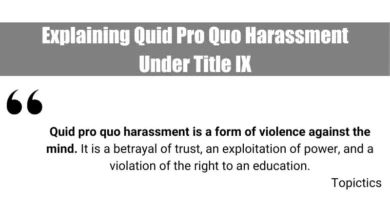Quid pro quo harassment is a class of sexual harassment that appears when a supervisor or other person in authority conditions an employment decision on an employee’s submission to sexual advances or other conduct. Quid Pro Quo is illegal under federal, state, and local laws. This article will discuss 13 powerful pieces of evidence on “How to Prove Quid Pro Quo Harassment” in the upcoming texts. The article will also provide additional tips on “How to Prove Quid Pro Quo Harassment.”
I. How to Prove Quid Pro Quo Harassment
An employee must show the following to prove quid pro quo harassment:
1. Direct Evidence
Direct evidence is the most convincing in a sexual harassment case because it clearly shows that the harasser was engaged in sexual harassment. However, it is important to note that even if there is no direct evidence of sexual harassment, a victim may still have a valid case if they can provide circumstantial evidence.
Direct Evidence Examples
- An email from a supervisor to an employee says, “If you want to get ahead in this company, you need to do what I say.”
- A text message from a coworker that says, “I’ll give you a raise if you go out with me tonight.”
- A voicemail from a client that says, “I’ll only do business with you if you sleep with me.”
- A photograph of a supervisor touching an employee inappropriately.
2. Witness Testimony
Witness testimony can be very helpful in proving a quid pro quo sexual harassment claim. Witnesses can testify to what they saw or heard the harasser say to the victim, and they can also testify to the victim’s demeanor and reactions.
For example, a witness could testify that they saw the harasser corner the victim in a hallway and make sexual advances towards them. Or, a witness could testify that they heard the harasser tell the victim that they would give them a promotion if they went on a date with them.
Witness testimony can be especially persuasive if it comes from multiple witnesses or witnesses considered credible, such as supervisors or other senior employees.
- Also, read Explaining Non-Sexual Quid Pro Quo Harassment.
- Also, read Workplace Quid Pro Quo Harassment: An Ultimate Guide.
- Also, read Educational Quid Pro Quo Harassment: An Ultimate Guide.
Witness Testimony Examples
- A coworker testifies that they saw the harasser touch the victim inappropriately at a company event.
- A supervisor testifies that they heard the harasser tell the victim they would be fired if they did not have sex with them.
- A customer testifies that they heard the harasser make sexual comments to the victim while they were at work.
- A human resources representative testifies that they received a complaint from the victim about sexual harassment and that the harasser denied the allegations.
3. Evidence of a Pattern of Behavior
If the harasser has a history of sexual advances to other employees or retaliating against employees who reject their advances, this can be strong evidence of quid pro quo harassment. This is because it shows that the harasser is likely to have engaged in the same behavior as the victim, even if there is no direct evidence of the harassment.
Examples
- A witness testifies that the harasser made similar sexual advances to them in the past.
- A human resources representative testifies that the harasser has been the subject of multiple sexual harassment complaints in the past.
- The victim presents evidence that the harasser has been disciplined for sexual harassment.
Evidence of a pattern of behavior can be very persuasive in a quid pro quo sexual harassment case. It shows that the harasser knew that their behavior was wrong and that they continued to do it anyway. This can help to convince a court or jury that the harasser is likely to have engaged in the same behavior as the victim, even if there is no direct evidence of the harassment.
- Also, read 20 Quid Pro Quo Harassment Examples and How to Stop Them.
- Also, read Quid Pro Quo History Examples: A Complex Dance of Mutual Exchange.
Continue reading How to Prove Quid Pro Quo Harassment.
4. Evidence of a Hostile Work Environment
If the harassment builds a hostile work environment for the victim, this can also be evidence of quid pro quo harassment. A hostile work environment is in which sexual harassment is so pervasive or severe that it interferes with the victim’s ability to do their job.
- 13 Powerful Resources for Victims of Quid Pro Quo Harassment
- Also, read 20 Financial Effects of Quid Pro Quo Harassment.
Examples
- The harasser makes sexual comments to the victim regularly.
- The harasser touches the victim inappropriately without their consent.
- The harasser spreads rumors about the victim’s sexual life.
- The harasser creates a hostile work environment for the victim’s coworkers, who are afraid to stand up to the harasser for fear of retaliation.
Evidence of a hostile work environment can help to support a quid pro quo sexual harassment claim by showing that the harasser created a workplace environment in which the victim felt uncomfortable and unsafe. This can make it more likely that the victim would have felt pressured to comply with the harasser’s demands, even if they did not want to.
- Also, read Explaining Quid Pro Quo Harassment Under Title IX.
- Also, read Quid Pro Quo Harassment: What It Is and How to Respond.
- Also, read The 13 Legal Implications of Quid Pro Quo Harassment.
5. Expert Testimony
An expert witness, such as an employment lawyer or a psychologist, can testify about the impact of quid pro quo harassment on victims. This testimony can help the Court understand the victim’s harm and determine whether the harasser’s actions were illegal.
Expert Testimony Examples
- An employment lawyer can testify about the legal standards for quid pro quo sexual harassment and the evidence needed to prove a claim.
- A psychologist can testify about the emotional and psychological impact of quid pro quo sexual harassment on victims.
Expert testimony can help the Court to understand the complex legal and psychological issues involved in these cases. Expert testimony can also help explain to the Court the harm that the victim has suffered, making it more likely that the Court will find in the victim’s favor.
- Also, read How to Create an Anti-Harassment Policy: 9 Effective Steps.
- Also, read How to Create an Effective Anti-Harassment Policy Under Title IX?
- Also, read Explaining Government Quid Pro Quo Harassment.
6. Evidence of the Victim’s Qualifications

Evidence of the victim’s qualifications and the harasser’s decision-making process can also be relevant in a quid pro quo sexual harassment case. If the victim is highly qualified for their position and the harasser makes a decision that adversely affects the victim’s employment, such as demoting or firing them, this could be evidence of quid pro quo harassment. This is because it shows that the harasser’s decision was likely motivated by the victim’s rejection of their sexual advances rather than by the victim’s performance or other legitimate factors.
Examples
- The victim presents evidence of their positive performance reviews and employment history.
- The victim presents evidence that the harasser made negative comments about the victim’s performance or employment after the victim rejected their sexual advances.
- The victim shows that the harasser made similar decisions to demote or fire other employees who rejected their sexual advances.
- Also, read Is Quid Pro Quo Illegal? 21 Accused Celebrities Examples.
- Also, read Why are Personality Disorders Stigmatized? An Analysis.
- Also, read 10 Ways Autistic People Influence Others.
Continue reading How to Prove Quid Pro Quo Harassment.
7. Evidence of the Victim’s Reaction to the Harasser’s Behavior
The victim’s reaction to the harasser’s behavior can also help prove a quid pro quo sexual harassment claim. For example, suppose the victim reacted in a way consistent with being harassed, such as appearing uncomfortable, anxious, or distressed. In that case, this can show that the harasser’s behavior was unwelcome and offensive.
8. Evidence of the Victim’s Performance after Harasser’s Behavior
If the victim’s performance declined after the harasser’s behavior, this could be evidence that the harassment was affecting their ability to do their job. For example, the victim may have difficulty concentrating, making mistakes, or avoiding the harasser.
9. Evidence of the Harasser’s Threats or Promises

Even if the harasser did not explicitly condition employment benefits on sexual favors if they made threats or promises to the victim that could be interpreted as such, this could be evidence of quid pro quo harassment. For example, the harasser may have threatened to fire the victim if they did not comply with their demands or promised the victim a promotion if they agreed to engage in sexual activity.
10. Telecommunication Call Records Evidence
Telecommunication call records can prove quid pro quo sexual harassment by showing the frequency and duration of calls between the harasser and the victim. This information can be used to establish a pattern of harassment.
Telecommunication call records are generally admissible in Court. However, the party offering the records as evidence must be able to authenticate them by showing that the records were accurate and properly obtained.
- Also, read How to Prevent Quid Pro Quo Harassment: 20 Effective Ways.
- Also, read 20 Ways to Prevent Quid Pro Quo Harassment Under Title IX.
Continue reading How to Prove Quid Pro Quo Harassment.
11. Conversation Recording Through a Mobile Phone or a Voice Recording Device Evidence
Conversation recordings from a mobile phone or a voice recording device can be used to prove quid pro quo sexual harassment by showing the harasser making sexual advances to the victim or by showing the victim reacting in a way consistent with being harassed.
For example, a voice recording could show a supervisor making sexual comments to an employee or the employee appearing uncomfortable or anxious in response to the supervisor’s behavior.
The conversation recording must be authenticated to be admissible in Court. This means that the person who recorded the conversation must be able to testify that the recording is authentic and accurately depicts what happened.
12. Video Recording Through a Secret Pen Camera Evidence

Video recording through a secret pen camera can be very strong evidence of quid pro quo sexual harassment. It can show the harasser making sexual advances to the victim or the victim reacting in a way consistent with being harassed.
For example, a secret pen camera video could show a supervisor making sexual comments to an employee or show the employee appearing uncomfortable or anxious in response to the supervisor’s behavior.
The video recording must be authenticated to be admissible in Court. This means that the person who recorded the video must be able to testify that it is authentic and accurately depicts what happened.
13. CCTV Footage Evidence
CCTV footage can also be used to prove quid pro quo sexual harassment. For example, CCTV footage could show a supervisor touching an employee inappropriately or show the employee avoiding the supervisor.
The CCTV footage must be authenticated to be admissible in Court. This means that the person who has custody of the CCTV footage must be able to testify that the footage is authentic and accurately depicts what happened.
Suppose you have video recordings, CCTV footage, telecommunication call records, or conversation recordings that could be used to prove quid pro quo sexual harassment. In that case, you should first consult with an experienced employment lawyer. An attorney can help you assess your case and develop a strategy for using the evidence to prove your claim. If you decide to file a claim with the Equal Employment Opportunity Commission (EEOC) or bring a lawsuit in Court, you must provide the evidence to the EEOC or the Court. The EEOC or the Court will then decide whether the evidence is admissible and, if so, what weight it should be given.
II. Additional Tips on How to Prove Quid Pro Quo Harassment
- Keep a record of everything. If you are being harassed, it is important to document everything that happens. This includes keeping copies of any emails, text messages, or other written or recorded communications from the harasser. You should also record any conversations you have with the harasser and any witnesses to the harassment.
- Be specific and consistent. When telling your story, be sure to be as specific as possible about the time, date, location, and nature of the harassment. Also, be consistent in your account of the events. This will help to show that you are credible and that your story is believable.
- Be honest. It is important to be honest and truthful when telling your story. If you try to exaggerate or embellish the facts, this could hurt your case.
- Talk to a trusted friend or colleague. If you feel uncomfortable talking to your employer about the harassment, you may want to talk to a trusted friend or colleague. They can offer you support and help you to think through your options.
- Show that the advances were unwelcome. You can do this by testifying verbally or in writing about how the advances made you feel uncomfortable or by showing that you tried to avoid the harasser.
- Show that the advances were conditioned on an employment decision. This can be done by showing that the harasser explicitly or implicitly threatened to take an adverse employment action if you did not submit to their advances.
- You must show that you suffered an adverse employment action. For example, you can show that you were fired, demoted, denied a promotion, or treated differently because you refused to submit to the harasser’s advances.
- Seek legal advice. If you are being harassed, you should consider speaking to an employment lawyer. An attorney can help you understand your legal rights and options.
III. Important Takeaways

The above evidence can help prove a quid pro quo sexual harassment claim. However, it is important to note that no evidence is conclusive. A court or jury will consider all the evidence to determine whether the victim has met their burden of proof.
It is also important to note that the victim does not have to prove that the harasser’s actions were motivated by sexual desire. Quid pro quo sexual harassment can occur even if the harasser is motivated by other factors, such as power or control.
If you are the victim of quid pro quo sexual harassment, it is important to gather as much evidence as possible to support your claim. This may include circumstantial evidence such as your performance reviews, employment history, and the harasser’s behavior. It would be best if you also tried to document the harassment by keeping a journal or recording any conversations you have with the harasser.









